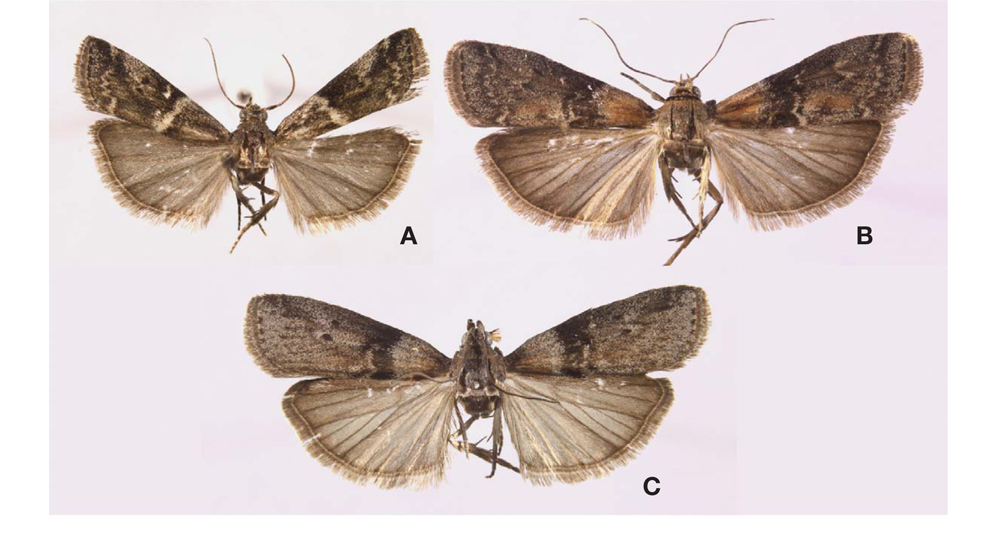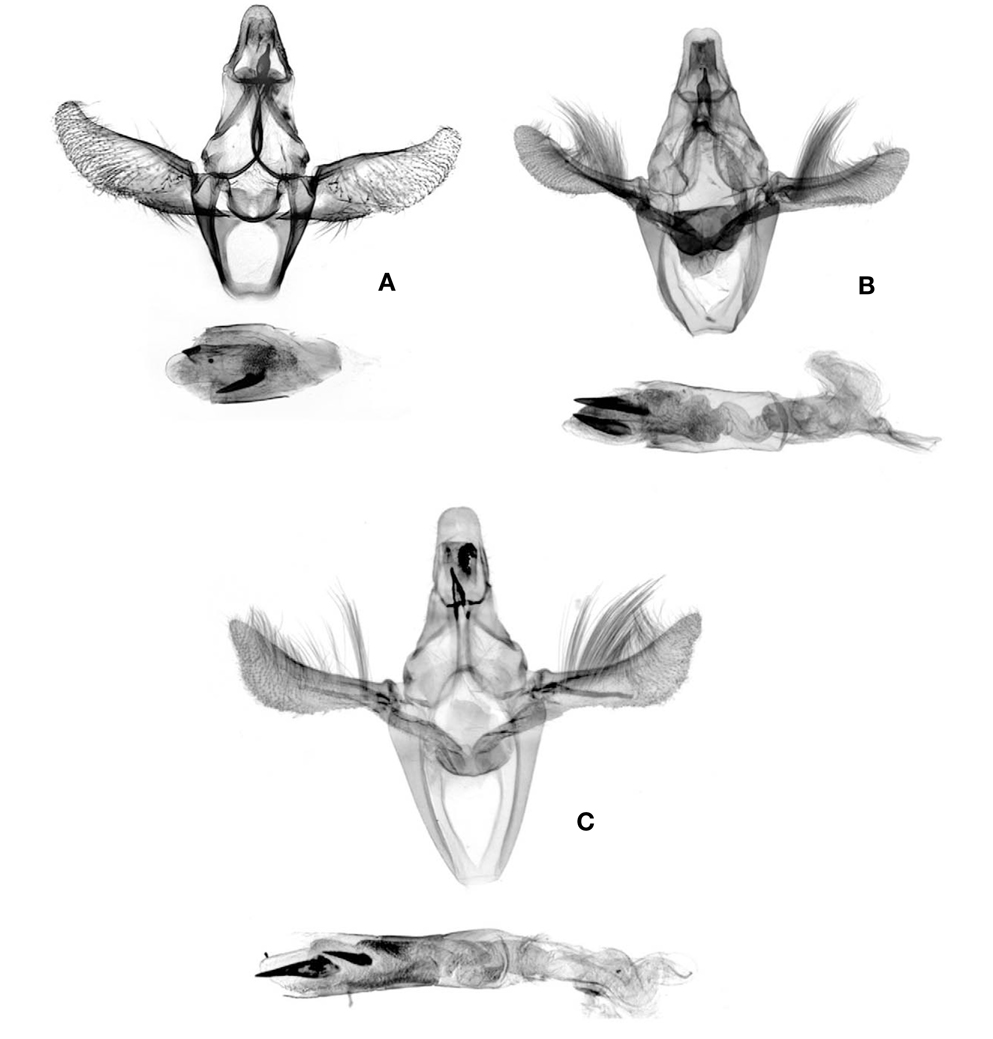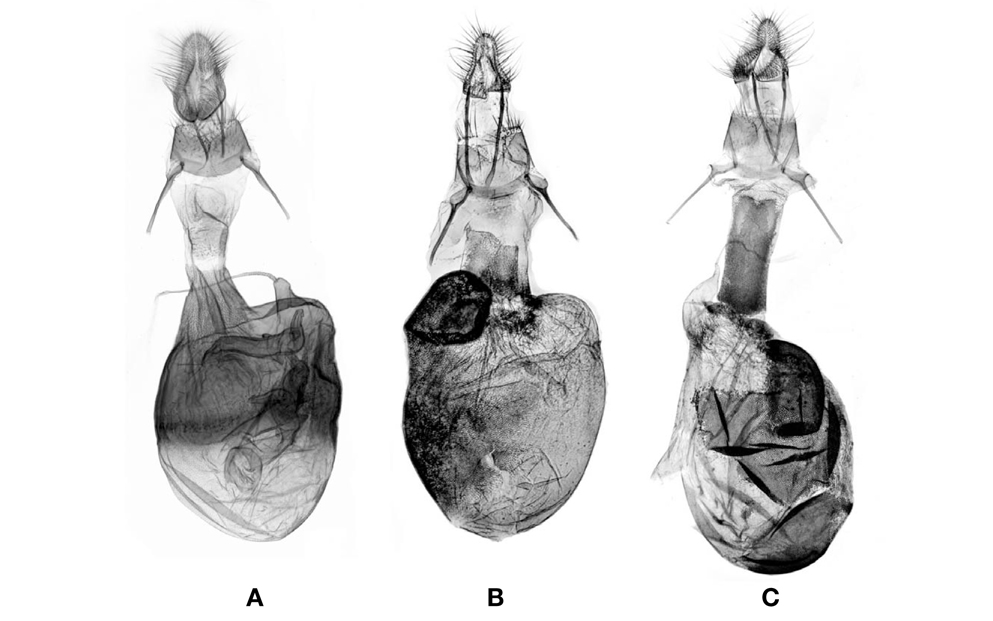



The genus
Materials used in this study were collected by light traps in NE China: Heilongjiang, Jilin, and Liaoning Provinces, and NE region of Inner Mongolia. Abbreviations used herein are as follows: TS, type species; TL, type locality.
Order Lepidoptera Linnaeus, 1758Family Phycitinae Ragonot, 1885
Sciota Hulst, 1888: 115. TS: Sciota croceellaHulst, 1888.Apodentinodia Roesler, 1969: 252. TS:Dentinosa obscurellaCaradja, 1937.Clasperopsis Roesler, 1969: 248. TS: Selagia nigerrimella Caradja, 1916.Paranephopterix Roesler, 1969: 259. TS: Salebria barteliCaradja, 1910.
Adult. Wingspan 17-29mm. Labial palpus upturned; maxillary palpus with long and slender scales in male, simple in female; antenna filiform, about 3/5-4/5 length of forewing, male with sinus at base of flagellum. Forewing with 11 veins; R2 and R3+4 approaching at base but not connate; R3+4 stalked with R5 for 2/3 length; M2 and M3 stalked at base. Hindwing with 10 veins; Sc+R1 and Rs approximate for 1/2 length beyond discall cell; M2 and M3 stalked about 3/5 length; discal cell about 1/3 length of hindwing.
Male genitalia.Uncus subtriangular; apical gnathos pointed or hooked; juxta rounded or elongate, without lateral lobes; aedeagus cylindrical, with 1-3 cornuti.
Female genitalia. Ductus bursae slightly sclerotized, shorter than corpus bursae; corpus bursae oblong, scobinate on inner surface or with minute sclerites.
>
Key to the genus Sciota Hulst from NE China
1. Basal area of forewing covered with reddish gray or brownish yellow color; antemedial line dentate ∙∙∙∙∙∙∙∙∙∙∙∙∙∙∙∙∙∙ 2 - Basal area of forewing gray; antemedial line straight; postmedial line distinct and dentate ∙∙∙∙∙∙∙∙∙∙∙∙∙∙∙∙∙∙ S. cynicella2. Antemedial line thin; postmedial line unclear; male genitalia with harpe rod-shaped, about 1/2 length of valva ∙∙∙∙∙∙∙∙∙∙∙∙∙∙∙∙∙∙S. fumella -Antemedial line dentate; postmedial line distinct; harpe rather small, thumb-shaped; transtilla knot-shaped on the top ∙∙∙∙∙∙∙∙∙∙∙∙∙∙∙∙∙∙ S. adelphella
>
Sciota cynicella (
Myelois cynicella Christoph, 1881: 54. TL: Russia, Amur. Nephopteryx cynicella: Ragonot, 1893: 272; Rebel, 1901: 35. Sciota cynicella: Yamanaka, 2004: 188.
Material examined. China: 3♂ , Mt. Bailang, Jianchang, Prov. Liaoning, 40˚ 48′28′′N, 119˚ 54′16′′E, 3 Jul 2012, legs. Qi MJ, Liu J, slide No. UIK-2755, 2756, 2748; 1♀, Mt. Bailang, Jianchang, Prov. Liaoning, 13 Jul 2011, leg. Qi MJ, slide No. UIK-2762.
Diagnosis. This species is similar with the congeners, but it can be distinguished by the following characteristics: basal area of forewing is covered with gray scales; antemedial line is straight; postmedial line is white and dentate. Male genitalia can be distinguished by the short aedeagus which is about 2/3 length of valva. Female genitalia can be distinguished by ductus bursae which is narrow at middle, and without sclerotized part; corpus bursae without patches on the inner surface.
Adult (Fig. 1A). Wingspan 17-21mm. Vertex grayish white, frons fuscous mixed with gray, labial palpus with 2nd and 3rd segment fuscous, inner side grayish white, 1st segment grayish white, 2nd segment about 3 times as long as 3rd segment, 1st and 3rd segment same in length, maxillary palpus about 2/3 length of 2nd segment of labial palpus, with tip grayish white, proboscis covered with fuscous scales at base, antenna fuscous; patagium and tegula fuscous; forelegs and middle legs with femur and tarsus fuscous mixed slightly with gray scales, tibia fuscous, each segments with gray tip; hindlegs with femur almost gray, tarsus grayish white, mixed with fuscous, tibia fuscous, each segment with gray tip. Forewing with ground color fuscous; antemedial line white, from 1/3 of basal costa, oblique outwardly, dentate; postmedial line white, thiner than antemedial line, oblique inwardly from costa, sinuous; median area with triangular white patch along costa; two black distal discoidal spots separated, terminal line gray, interneural spots black, fringe gray. Hindwing with ground color gray, terminal line pale gray, fringe brownish gray.
Male genitalia (Fig. 2A). Uncus subtriangular, rounded at top; gnathos coniform, with middle enlarged, pointed at tip, about 1/2 length of uncus; valva curved upwardly, rounded at apex, costa well sclerotized, basal part broad, pointed at tip, shorter than length of valve, sacculus stick-shaped, about 2/5 length of valva, Juxta semicircular at base, lateral lobes oblong, with setae at tips; vinculum U-shaped, about 2/3 length of valva, saccus concave slightly; aedeagus rather stout, about 2/3 length of valva, with two cornuti, bigger one thorn-shaped, smaller one comma-shaped.
Female genitalia (Fig. 3A). Apophyses posteriores about same length as apophyses anteriores, and with slightly enlarged base; antrum rectangular, with lateral sides slightly folded inwardly; anterior half of ductus bursae scobinate, corpus bursae oval, posterior part granulated, and with longitudinal wrinkles, signum absent; ductus seminalis from posterior part of appendix bursae.
Distribution. China(Liaoning), Japan, Russia(Primorye).
Remarks. In the present study, this species is reported for the first time from China.
>
Sciota adelphella(
Phycis adelphella Fischer von Röslerstamm, 1836: 50. TL: Japan. Nephopterix adelphella: Inoue, 1954: 135; Park, 1983: 151; Sinev, 1986: 281. Sciota adelphella: Emmet, 1988: 227.
Material examined. China: 1♂, Mt. Bailangshan, Jianchang, Prov. Liaoning, 11 Jul 2011, leg. Qi MJ, slide No. UIK-2961; 1♂, Mt. Bailangshan, Jianchang, Prov. Liaoning, 40˚48′14′′N, 119˚54′41′′E, 4 Jul 2012, legs. Qi MJ, Liu J, slide No. UIK-2965; 1♂1♀, Xianjingtai, Helong, Prov. Jilin, 42˚18′49′′N, 129˚04′13′′E, 10 Jul 2012, legs. Qi MJ, Liu J, slide No. UIK-2916, 2964; 1♀, Mt. Changbai, Erdao Electric Plant, Prov. Jilin, 42˚24′11′′N, 128˚06′04′′E, 7 Jul 2012, legs. Qi MJ, Liu J, slide No. UIK-2946; 2♀, Mt. Changbai, West Gate, Prov. Jilin, China, 42˚03′09′′N, 127˚39′44′′E, 8 Jul 2012, legs. Qi MJ, Liu J, slide No. UIK-2958, 2960; 3 ♀, Changxin Forestry Center, Helong, Prov. Jilin, 42˚19′ 51′′N, 128˚ 57′14′′E, 11 Jul 2012, legs. Qi MJ, Liu J, slide No. UIK-2655, 2943, 2947.
Diagnosis. This species is similar with the congeners, but it can be distinguished by the following characteristics: basal area of forewing is covered with reddish gray scales; antemedial line is white, sinuous and clear; postmedial line is grayish white and dentate. Male genitalia can be distinguished by the rather small and thumb-shaped harpe. Female genitalia can be distinguished by ductus bursae which is about 1/2 length of corpus bursae, and only 1/3 of anterior part is sclerotized; lateral and posterior part of corpus bursae with granule and patches on inner surface.
Adult (Fig. 1B). Wingspan 21-29 mm. Labial palpus fuscous; basal area and posterior part of median area of forewing pale yellowish gray or reddish gray; antemedial line white, sinuous and clear; postmedial line grayish white and dentate.
Male genitalia (Fig. 2B). Gnathos rectangular at base, small thorn-shaped at top, about 1/2 length of uncus; transtilla connected at top, the connection knot-shaped or quadrate; valva with apical part rounded; harpe rather small, thumb-shaped; vinculum U-shaped, same length with valva.
Female genitalia (Fig. 3B). Ductus bursae straight, about 1/2 length of corpus bursae, only 1/3 of anterior part sclerotized; lateral and posterior part of corpus bursae with granule and patches on inner surface.
Distribution. China(Jilin, Liaoning, Inner Mongolia, Hebei, Henan, Jiangxi, Anhui, Hubei, Sichuan, Fujian, Shaanxi, Qinghai), Korea, Japan, Russia, Europe(Germany, Hungary, France, Netherlands).
>
Sciota fumella (
Phycis fumellaEversmann, 1844: 558. TL: Russia. Nephopterys [sic] fumella: Herrich-Schäffer, 1848: 72. Nephopteryx [sic] tristis Alphéraky, 1880: 47. TL: Russia, Amur, Tangarog. Salebria fumella: Ragonot, 1893: 355. Selagia nigerrimella Caradja, 1916: 11. TL: Sajan, Arasagun gol. Nephopterix(Clasperopsis) nigerrimella: Roesler, 1969: 249. Nephoterix fumella: Sinev, 1986: 281; Paek and Bae, 2001: 303. Sciota fumella: Palm, 1986: 41, Pl. 1, fig. 20.
Material examined. China: 1♂1♀, Mt. Bailangshan, Prov. Liaoning, 40˚48′28′′N, 119˚54′16′′E, 11 Jul 2011, legs. Qi MJ, slide No. UIK-2959, 2962; 5♂, Xianjingtai, Prov. Jilin, 42˚18′49′′N, 129˚04′13′′E, 10 Jul 2012, legs. Qi MJ, Liu J, Liu SZ, slide No. UIK-2902, 2908, 2911, 2914; 1♂, Jiagedaqi, Daxinganling, Prov. Heilongjiang, 50˚ 11′51′′N, 124˚ 12′18′′E, 18 Jul 2012, legs. Qi MJ, Liu J, slide No. UIK-2845.
Diagnosis. This species is similar with the congeners, but it can be distinguished by the following characteristics: base of forewing is pale yellowish gray, and the antemedial line is thin; postmedial line is unclear. Male genitalia can be distinguished by trapezoid uncus; gnathos is coniform and about 1/3 length of uncus; harpe is rod-shaped, and about 1/2 length of valva. Female genitalia can be distinguished by the ductus bursae which is straight and almost sclerotized, and about same length as corpus bursae; anterior, middle and posterior part of corpus bursae with granule and patches on inner surface.
Adult (Fig. 1C). Wingspan 22-26mm. Labial palpus with inner side brownish yellow; base of forewing pale yellowish gray, antemedial line thin and only posterior part clear; postmedial line unclear.
Male genitalia (Fig. 2C). Uncus trapezoid; gnathos coniform, about 1/3 length of uncus; valva with apical part sharped; harpe rod-shaped, about 1/2 length of valva; vinculum U-shaped, with saccus flat.
Female genitalia (Fig. 3C). Ductus bursae straight and almost sclerotized, about same length as corpus bursae; anterior, middle and posterior part of corpus bursae with granule and patches on inner surface.
Distribution. China (Heilongjiang, Jilin, Liaoning, Henan, Hebei, Yunnan), Japan, Russia, Europe.
Remarks. In this study, it is reported for the first time from Northeast China.


